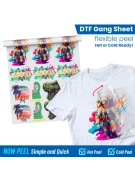DTF Transfers vs Sublimation Transfers

In previous posts, we talked about some of the most common applications of DTF printing to help you learn more about the variety of uses that DTF transfers can have. Now we will talk about sublimation vs dtf.
Nowadays, the updates in technology make it possible to print almost anything we want. However, there may be questions about the advantages of DTF Transfers in comparison to other printing techniques, such as vinyl or sublimation.
That’s why the team at DTF Transfers Now has prepared this article to assist you with your decision, whether you are interested in integrating a new printing technique or want to choose the best option for your printing project, gift, or a product you want to personalize.
What is a DTF Transfer?
First of all, we want to clarify what DTF printing is. It stands for direct-to-film printing, and it is a relatively new technology in the field of garment decoration and textile printing.
DTF printing is an alternative to traditional methods like screen printing, screen print heat transfer, and direct-to-garment (DTG) printing. It offers unique advantages, especially in terms of flexibility, no limitation on colors, no minimum orders and the ability to print on various fabrics.
DTF Process
As we mentioned, DTF printing is a contemporary method that changes how we can transfer designs onto textiles.
The process starts with creating a design using design programs. Those designs are then saved as PNG or PDF and sent to be printed with specialized DTF inks. These inks are formulated to work seamlessly with DTF printers, equipped with print heads designed for precision and detail.
The chosen design is printed onto a unique heat-sensitive film, which acts as a transfer medium. This film is crafted to absorb and retain the DTF inks, ensuring optimal color vibrancy and clarity. After the designs are printed on the film, they go into commercial grade ovens where they are first coated with a white adhesive powder and then heated to high temperatures for curing. Once the design leaves the oven, , the next step involves transferring it into the fabric.
The film, with the printed design facing the textile, is carefully positioned. The designs are then transferred onto the fabrics through a commercial-grade heat press or similar device, activating the inks on the film and ensuring their transfer to the fabric. The heat aids in the ink transfer and helps seal the inks onto the textile, ensuring durability and washability.
What is sublimation?
On the other hand, sublimation refers to a process where the dye (in this case, ink) is transformed directly onto the polyester garment by turning into a gas without passing through the liquid phase.
Sublimation printing is commonly used for creating high-quality, full-color prints on different of items, especially polyester fabrics and polymer-coated substrates. The sublimation process offers vibrant and durable results, making it popular for apparel, promotional products, and personalized items. Unlike DTF transfers, the designs are absorbed into the fabrics surface, creating a permanent bond to the fabric.
Sublimation printing process
As we mentioned, sublimation printing offers vibrant and durable designs that can be printed on several surfaces. The process begins with the creation of a design on a computer and then printed onto sublimation paper utilizing specialized sublimation inks.
To have a successful application of the sublimation transfer, we need to apply very high heat to the paper for a long period of time. The combination of heat, time and pressure applied through a heat press, induces the sublimation inks on the paper to transform into a gas. This gas permeates the substrate, becoming an integral part of its structure upon cooling.
Sublimation vs DTF
Now that you learned more about these types of printing techniques, it is time to compare them, so the next time you need to print a design, you can choose the best option for you.
1.- Printing Process
To summarize, DTF Printing involves printing the design directly onto a heat-sensitive film and has a white powder adhesion on the backing, which is later transferred to the fabric using heat and pressure; on the other hand the sublimation process requires special sublimation inks that can transform into a gas when heated after printed on sublimation paper.
2.- Best Materials
DTF printing can be used on various fabric types, including cotton, polyester, and blends and all garment colors. Sublimation printing is only suitable for white or light polyester fabrics or materials with a white polyester coating, as the process relies on the sublimation of dyes into synthetic fibers. If your project requires dark garments, your best choice is DTF transfers.
3.- Durability and color vibrancy
DTF transfers offer vibrant and detailed prints with a wide range of colors since this technique can produce durable prints with great washability and colorfastness.
Sublimation printing provides high-resolution, photo-quality prints with vivid and saturated colors, the sublimation inks create prints that become part of the substrate, making them resistant to fading and washing.
4.- Cost
Last but not least, a key factor in deciding whether to use DTF printing or sublimation is their cost.
Purchasing DTF printers and equipment will require a high upfront cost. In addition to the high startup, DTF printing will require months of testing in order to get the formula correct. Sublimation equipment is a bit more affordable, but the materials are very high in price. If you are obtaining both from a reputable vendor, DTF prints tend to be on the more economical side.
The best method will depend on your specific needs at the time of your project. Using DTF transfers will give you more liberty to work with various materials and garment colors. If you choose sublimation printing, you will be limited to white or light polyester garments.
Now that you have more information about the differences between DTF printing and sublimation, share this article on your social media and stay tuned on our blog to keep updated on the latest news.





Leave a comment